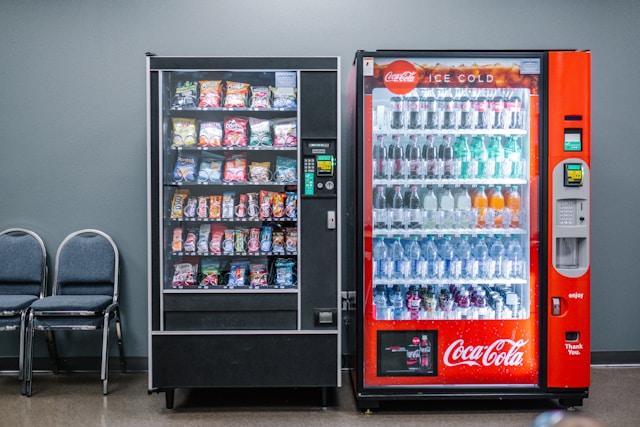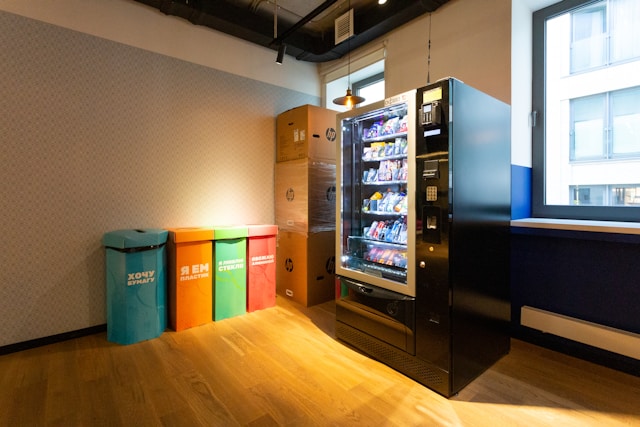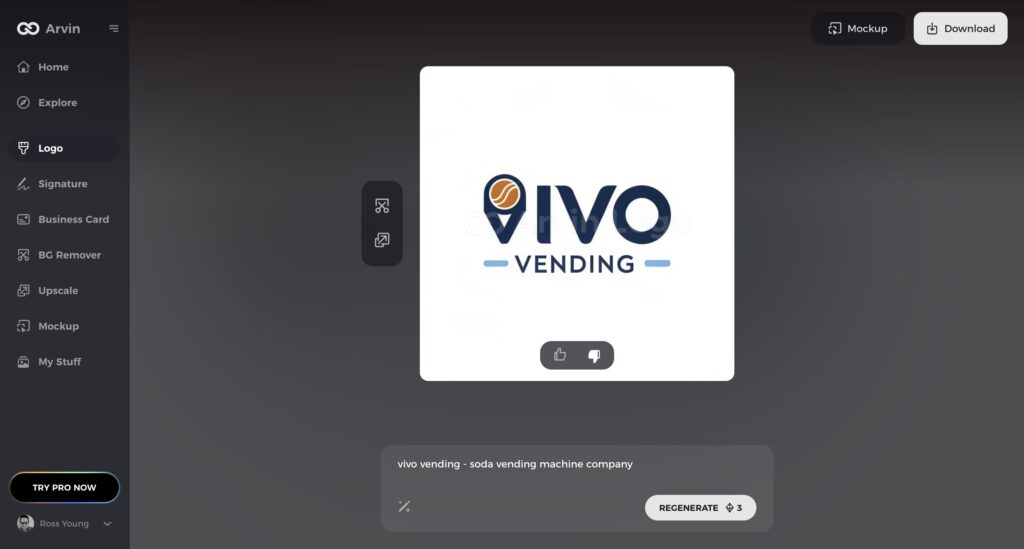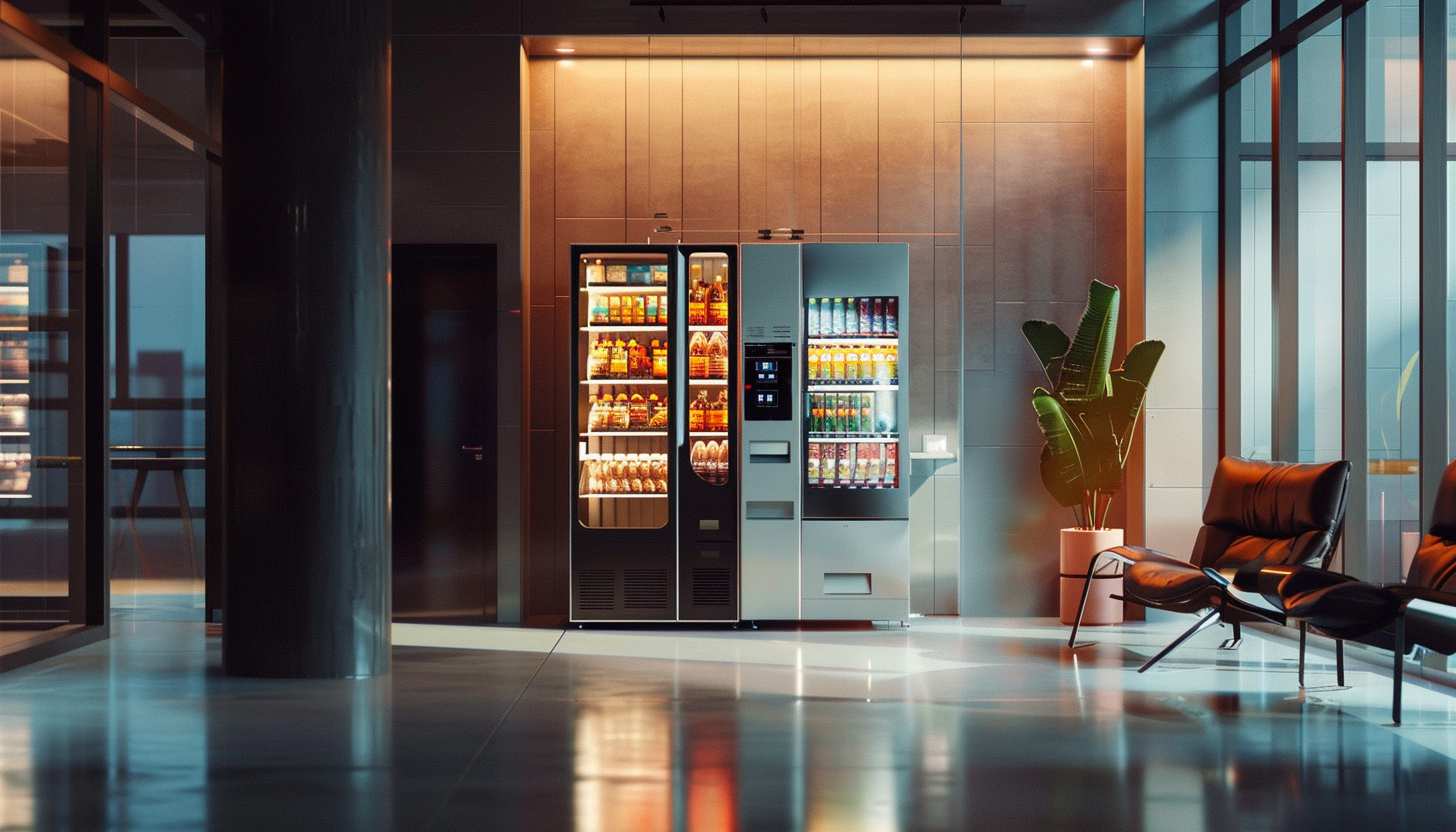
As we showcase in this article, learning how to start a vending machine business is easier than you might think. Whether you want a side hustle or are looking for a full-time gig, a vending machine enterprise can yield impressive returns.
So, without further ado, join me as I explain precisely how to get your vending machine business off the ground this year. I reveal figures, details, and expert advice and even show you how to use the latest AI to make your vending machine business successful.
First: Is a vending machine business profitable?
Research shows that an average vending machine can return between $5,000 and $6,000 per year to its owner, excluding labor costs. Moreover, the global vending machine market is huge, with expectations suggesting that it will rise to $25 billion by 2027.
However, the crucial thing to remember is that vending machine success is all about location. Low-traffic areas might take in $10 to $20 per day, while machines in high-traffic areas can do up to $100 per day.
The type of refreshments that your vending machine sells also makes a big difference to its profitability. Business owners that focus on niche segments (energy drinks in gyms, for instance), tend to do better than those offering generic products at shopping malls or in car park lobbies.
The costs of the business depend on numerous factors, including which machine you buy and whether you need to pay rent. Here’s an overview of some of the costs, though these can vary significantly from business to business:
| Machine type | New or used | Average price |
| Bulk vending machine | Used | $100 – $400 |
| Bulk vending machine | New | $500+ |
| Food and beverage vending machine | Used | $2,000 – $3,000 |
| Food and beverage vending machine | New | $4,000 – $10,000 |
| Specialty vending machine | Used | $5,000 – $10,000 |
| Specialty vending machine | New | $10,000+ |
How much does the rent cost?
In addition to the cost of the machine, you will need to factor in how much rent you need to pay the property or landowner to have your machine in place. There are a few ways to negotiate this, and the arrangement will depend on both of your requirements:
- No charge: In rare cases, a business owner might let you install a vending machine without charge. This may happen if they’re keen to provide refreshments to their customers but don’t want the hassle of buying and maintaining a machine themselves.
- Rent per sale: Some vending machine business owners are required to pay a pre-agreed rent per sale. For instance, this might be $0.05 or $0.10 per $1.00 of product that you sell. This way, you don’t have to pay anything upfront, but your bottom line will be affected.
- Weekly, monthly, or annual rent: Another approach is to pay weekly, monthly, or annual rent, regardless of how much you sell. If you’re in a high-traffic area and your machine is busy, negotiating a flat rental rate will be favorable to your business.
So, when considering the costs attached to your vending machine business, the purchase price of the machine and the ongoing rent are two of the biggest. We touch on a few others later in this article.
How does a vending machine business work?
In many respects, a vending machine business is unique. It’s not location-dependent, requires comparatively little labor and practically no overheads, and can be run as a hugely successful side hustle if done well.
As a prospective operator, you need to decide which type of vending machine to buy, where to put it, and what type of refreshments you will sell. We explore some of the options in the next section.
Some vending machines are operated by global chains like Starbucks (coffee machines), Coca-Cola (soda vending machines), and Nestle (candy vending machines). These operations tend to get prime real estate and are found at sports stadia, gas stations, and malls with hundreds or even thousands of people passing by every few minutes.
Independently-owned vending machine businesses
The other growing segment of the market sees vending machines operated by entrepreneurs and sole traders. It’s not uncommon for some business owners to operate tens or even hundreds of vending machines, while others may maintain just one or two to supplement their family’s income.
Given that you’re reading this article, I’m assuming that you fall into the latter category. You’re probably exploring how to start a vending machine business with one or two machines in specific locations close to your home.
In recent years, vending machines have come a long way from the original concept. Historically, the buyer placed coins into the slot to buy generic snacks, ranging from a Mars Bar to a can of Pepsi.
Today, the industry has welcomed the emergence of advanced machines incorporated with AI technology. These machines feature advanced dispensing systems and can notify you remotely when the machine needs to be restocked.
Moreover, vending machines today accept numerous payment methods, including debit cards, credit cards, and even contactless mobile payments. This makes them potentially even more profitable for business owners, even though the operating costs have also increased.
Choosing a vending machine: 3 options

If you’re looking into how to start a vending machine business, you’re probably aware that there are numerous machine types that you can invest in. Some are more profitable than others, while some require more maintenance and restocking. Here are the most common types that you can consider for your vending machine business this year:
Option 1: Bulk vending machines
A bulk vending machine is one of the most common types of machines in the market today. They’re low-tech and widely available, and you usually see them at gas stations, malls, and car parks. They dispense candy, gumballs, and other products with a long shelf life.
Many of these machines accept cash only and are old-fashioned compared to many of the modern vending machines that have emerged in recent years. But this has its advantages. Bulk machines are still popular today because they don’t require much maintenance and are extremely profitable when placed in good locations. They’re also relatively cheap to buy, and you can often pick one up for a few hundred dollars.
Option 2: F&B vending machines
There’s a wide range of food and beverage (F&B) vending machines out there. Think about all the places you have recently visited. Whether it’s the gym, a train station, a gas station, a roadside service station, or even a public building like a library or police station, you will probably notice a food and beverage vending machine inside.
There are many types, but these machines tend to vend the following:
- Ice cold drinks like sodas.
- Hot beverages such as tea and coffee.
- Ice creams and iced lollies.
- Specialty drinks like protein shakes and energy drinks (specifically in gyms).
Hot food. Amsterdam’s Automats (FEBO) is a brilliant example of a hot food vending machine business that runs on a large scale.
F&B vending machines tend to be considerably more expensive than bulk machines as they require a heating or cooling component. Also, more ongoing maintenance is required, as is regular topping up.
Still, F&B vending machines in prime locations tend to command some of the biggest returns for owners, so they’re well worth investing in. You can expect to pay $2,000 or more for a good quality F&B vending machine.
Option 3: Specialty vending machines
While vending machines started out as an opportunity for people to buy snacks and drinks, they’ve become much more niche in recent years.
For example, you can now buy SIM cards from vending machines in airport waiting lobbies and even jewelry and gifts from other machines. This is actually one of the fastest-growing segments in the vending machine industry and may reshape the future of in-person shopping at malls and other outlets.
As these machines tend to sell more expensive products, they have more advanced security features and payment options. After all, if you’re selling something in a machine for $50, you can’t expect someone to post $50 worth of quarters into the slot!
Most of these machines have contactless payment facilities and dispense detailed receipts. They tend to cost tens of thousands of dollars to buy and require software and the latest technology to operate correctly.
Still, specialty vending machines can serve a purpose in so many locations, from your local gas station to a kids’ amusement park. If you get the location right, a specialty vending machine can yield significant returns.
How to start a vending machine business in 5 steps
Now I’ve covered the basics and looked at the potential profitability of the business, I want to take you through the step-by-step process that will help you get your vending machine business underway:
Step 1: Find a profitable location
Before you do anything, my advice is to spend as much time as possible looking for a profitable location for your vending machine business. One of the biggest barriers to entry for this line of work is that practically everywhere you can think of already has a vending machine.
Generic options include shopping malls, schools, malls, hospitals, transport hubs, office buildings, apartment blocks, and car dealerships. These places are well-served, and most already have numerous vending machines.
Therefore, thinking outside the box is crucial when searching for a profitable location.
For your vending machine to return a decent profit, you need to pick a location that:
- Doesn’t currently have a vending machine (or at least doesn’t have a machine that sells what you want to sell).
- Has a lot of foot traffic and passing trade.
- Is frequented by your target market. For instance, there’s little point in vending vapes at a kids’ play area.
- Will not be prohibitively expensive in terms of rent.
- Is close enough to your home or place of work so you can service it regularly.
Potentially profitable locations for a vending machine in 2025: Three examples
If you fail in one of the key areas above, you might have a problem on your hands. One way to approach this is to think about the places you regularly attend in your day-to-day life. Could a vending machine business work at any of them? For instance:
Gyms
You could set up a specialty vending machine that sells things like padlocks, towels, and goggles for the swimming pool. Alternatively, a drinks machine with protein shakes and energy drinks might work well. If your gym is a chain, you could look at installing your machines in several properties.
Kids’ play areas
Play parks are filled with hungry and thirsty kids, as well as parents who sit around for hours waiting for their little ones to stop playing. If there’s a kids’ play area near you without a vending machine, it could be a lucrative spot for a bulk machine selling candy or a specialty machine selling toys.
Local sports venues
While major sporting venues and big stadia will have the catering covered, the may be a gap in the market for local sports venues. For instance, a vending machine could benefit your local Little League field or a local football pitch used by dozens of amateur teams. Like at the gym, you could sell sports and energy drinks, while catering to the spectators with candy, sodas, and other refreshments.
These are just three examples, but they can serve as a starting point for your research. While gas stations, malls, and transport hubs are obvious places for vending machines, they’re overserved. You will almost certainly find that every bus station, shopping mall, and gas station in your area already has at least one vending machine.
Securing a location for your vending machine business
Identifying a potentially profitable location for your vending machine business is only half of the battle. The next step is to approach the business owner, manager, or property owner to ask if they would be willing to enter a partnership.
Maybe the reason that they don’t have a vending machine is that they don’t want one, and they’ve batted off interest in the past. In this case, you will have to show them why your business can work and how it can make them passive income.
Your first step should be to approach the business owner or manager directly. Explain that you’re keen to install a vending machine at their business, and you want to gauge their interest. Be clear about what you want to sell and why. Then, present some income-sharing ideas as introduced above.
The worst they can say is no, and if the initial conversation goes well, you can agree in principle on that location. It’s now time to decide on the machine you want to invest in.
Step 2: Decide which type of machine to invest in & where to buy it from
I’ve already presented the three main types of vending machines you can choose for your business, so I’m not going to repeat myself here.
After speaking to the person in charge of your proposed location, you probably have a good idea by now of which type of vending machine you want to purchase. So, it’s time to find the right machine for your needs and budget.
Here are a few options to begin your search:
Second-hand marketplaces
If this is your first vending machine business and you’re on a tight budget, I recommend looking into second-hand options first. Hop on eBay, Craigslist, and Facebook Marketplace to find great deals on bulk, F&B, and specialty vending machines.
You can often find great deals on these platforms, but I advise you to visit the seller before buying a machine. Check its condition and ensure it works before buying it. If your business takes off, you can always buy a newer model if you land a profitable location.
Manufacturer websites
If you don’t want to buy a second-hand vending machine, go directly to the manufacturer. There are many trusted vending machine manufacturers out there, each serving a different segment of the market. Depending on where you live, I recommend checking out the following manufacturers as a starting point:
- Azkoyen Group (Europe)
- RS Hughes (North America)
- Fuji Electric (Asia)
- Sandan Corporation (Asia)
- Crane Merchandising Systems (North America)
The manufacturers don’t always publish their prices directly on their websites, so you may have to contact them directly to submit an inquiry. Feel free to shop around and consider quotes from numerous firms before settling on your preferred machine.
Wholesale marketplaces
Another option is to use a wholesale marketplace to buy your vending machine. This can be cheaper than dealing with the manufacturer directly. It also gives you more choices and better options when comparing the key features of the machines you’re interested in.
Alibaba is a great starting point if you’re interested in this route. Other popular wholesale marketplaces include Faire, Sale Hoo, and Global Sources.
Before buying a vending machine, conduct thorough research and list a few of the options available to you. This way, you can then compare and contrast the options before deciding which to buy and whether it suits your business objectives.
Step 3: Create your business & launch your brand
With the research behind you, it’s time to create your business and launch your brand. Hopefully, by this stage, you know where you’re going to place your vending machine and which type of machine you want to buy. It’s now time to iron out the key details and to consider the following:
Company registration, structure, & plan
Whether you’re running your vending machine business as a full-time gig or a side hustle, you need to come up with a business name. You might like to include your initials, a family name, or your area of coverage. There are many ways to come up with a good name – read our blog that explains how to create a business name for more inspiration.
Next, decide on the structure of your business. Most vending machine business owners are sole traders, at least at first. But you will still need to register as a company. Every country has different requirements for business registration, so ask Arvin to reveal how to register a company in the relevant place. This will save you a lot of time and effort.
At this stage, you should also write a simple business plan, including your initial financial projections. It doesn’t have to be comprehensive, but make sure you get your ideas and projections down on paper. You should also look into creating a business bank account so you can conduct transactions as soon as your business is registered.
Launching your brand
It’s also time to launch your vending machine business brand. This goes beyond the business name and deals with your business values, ethos, and objectives.
For the purposes of illustration, I want to create a vending machine business called Vivo Vending. One of the first things my brand needs is a professional logo. So, ask Arvin to create a stunning logo for your vending machine business for free.
This way, you can save time, money, and effort, which you can spend on other aspects of your business launch. Check out the awesome label that Arvin’s AI tool created for Vivo Vending in less than ten seconds:

The logo is modern, eye-catching, and a great beacon for my brand. If you’re not happy with the initial results, you can request changes or start again from scratch.
Following your logo creation, consider the following:
- Put together a simple website for your vending machine business. You can use a free website builder tool and spend a few bucks on a relevant domain.
- Create some branding guidelines that ensure all of your marketing is consistent and professional. Read our guide to branding guidelines for more details.
- Start marketing your brand on social media and create flyers that you can use to approach business owners offline.
- Think about whether social media is a good avenue for marketing, given that this is a unique type of business. You might want to use LinkedIn rather than Facebook, given that you may wish to focus on B2B rather than B2C sales.
Step 4: Secure your finances: Buy, install & stock your machine
You’re now ready to operationalize your business. The first step is to secure your finances. How are you paying for your vending machine? Common options include:
- A bank or personal loan (often available for up to $10,000 with a simple online application).
- A startup loan from your state.
- Your savings. If you have stock or bonds, you will need to convert them to cash.
- A loan from a friend or family member – make sure you sign a loan agreement and agree on any interest repayments in advance.
Take the required steps to secure your business finance and add it to your newly opened bank account. You can then use one of the purchase methods introduced above to buy your vending machine.
You will need to get it delivered to the agreed location and install it correctly. Professional installation is advised for vending machines, as it’s more complicated than turning it on and plugging it into the mains!
If you buy the machine directly from the manufacturer, they will help you with installation. If not, contact a local electrician or vending machine repairperson to install the machine on your behalf.
Stocking your vending machine
A sizeable part of your initial investment needs to contribute to stocking the vending machine. It’s absolutely crucial that you shop around and buy the stock at the best available price. After all, if you buy your stock at a high price, you will shred your margins.
No matter what you’re buying, it’s nearly always cheaper to buy it in bulk from a wholesale website or depot. To do this, you might need to create a trade account, but don’t skip this step. It will save you lots of money in the long run and make your vending machine more profitable.
I recommend buying at least two to three months’ worth of stock from the outset. This will help you access a good price and will make your life easier when it comes to servicing and stocking up your machine going forward.
Step 5: Establish an ongoing schedule for servicing, maintenance, and repairs
One of the most essential aspects to consider when learning how to start a vending machine business is how frequently you need to service and maintain your machine.
It’s super important to look for a location that’s close to your home or workplace so you can easily visit your vending machine in an emergency. You don’t want to travel across state lines or 50 km or more just to stock up your machine.
Then, I recommend establishing a weekly, quarterly, and annual servicing and maintenance schedule. Below are the tasks you should carry out at each juncture:
Weekly
- Stock up your inventory.
- Check for any damage to the machine’s interior and exterior.
- Look at the dates on any food and drink items and make sure they’re fine to sell.
- Perform a simple cleaning of the inside and outside of the machine.
- Ensure that all payment mechanisms work by testing the machine.
- Collect the money (if your machine accepts coins or notes) and document all sales from the week. If you’re in a high-traffic area, you may want to do this bi-weekly.
- Keep a maintenance and cleaning log to document your weekly schedule.
Quarterly
- Conduct a thorough examination of the machine and ensure all interior and exterior parts are working. Order replacement parts if any are damaged.
- Calibrate your payment systems and update the software if required.
- Perform any hardware updates if necessary.
- Complete a deep cleaning of the machine.
- Keep a maintenance and cleaning log to document your quarterly schedule.
Annually
- Fully service your vending machine. Lubricate all parts and check all mechanisms are working. You may wish to hire a professional to do this on your behalf.
- Review all sales from the year and consider adding and removing products to enhance your business.
- Consider upgrading your machine if you have the funds available to do so.
- Comprehensively clean the vending machine.
- Keep a maintenance and cleaning log to document your weekly schedule.
Ultimately, you must take the necessary steps to keep your vending machine in good working order. Get into the habit of logging all services and repairs, and document how frequently you clean your machine.
If your machine operates in a high-traffic area and takes in a lot of cash (as opposed to contactless payments), you may wish to conduct your weekly servicing every three or four days.
How to start a vending machine business: Threats and challenges to be aware of

Now that I’ve run through the five steps that explain how to start a vending machine business, I want to provide you with some expert feedback gleamed from current vending machine business owners. Here are some of the things you must think about before getting into this potentially lucrative market:
Location is everything
The location of your vending machine is the single most important thing to think about. Therefore, spend as much time as possible researching possible locations before settling on a prime spot.
For instance, one vending machine owner I spoke to regretted installing a vending machine at the car park side of a bowling alley. He thought that visitors would see the vending machine from their cars and purchase refreshments before heading home.
But in reality, 99% of people headed straight for the entrance and ignored the machine entirely. Therefore, always choose a location with lots of foot traffic. Most people buy from vending machines on impulse as they pass by, so bear this in mind.
Go for a machine with advanced payment options
Cash is dying a slow death. For instance, the latest research from Pew shows that four in ten Americans don’t complete any weekly transactions with cash.
To serve this new “cashless economy,” your vending machine should accept contactless payments. While the software will cost you more upfront, it’s a worthwhile investment.
Moreover, when you accept cashless payments, you make your life easier. You don’t have to physically empty the cash and deposit it in your bank account. This saves both time and fees, which can help the success of your vending machine business.
Conclusion – How to start a vending machine business
A vending machine business remains a great enterprise to get into. However, it has become more competitive in recent years, so you need to do your research before setting up. As a reminder, here are the five key steps to take to get your business off the ground:
- Find a profitable location. Spend as much time as possible researching potential spots to find a location that will most likely yield a profit.
- Decide which type of vending machine will suit your business. Then, research the used and new market to find a machine that suits your budget.
- Create a business structure, launch your brand, and start marketing your vending machine business.
- Secure your finances, be it a loan, investment, or savings withdrawal. Then, buy and stock your vending machine.
- Decide how to service and maintain your vending machine and create a log to chart your progress.
You can also read our FAQ below for more details on how to start a vending machine business that will become profitable in 2025.
How to start a vending machine business FAQ
Is a vending machine business profitable?
It certainly can be. If you pick a good spot, your vending machine can pull in up to $6,000 annually (on average), with a profit of between $300 and $600 per month.
How long does it take for a vending machine to pay for itself?
For most vending machine business owners, the first machine pays for itself within about one year.
What is the most profitable item for vending machines?
Standard bulk vending machines that sell soda, candy, chocolate, and other sweet goods remain extremely profitable and a good option if you’re new to the industry.








